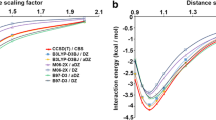Abstract
The interaction of two identical polar neutral molecules is modeled by two equal but oppositely charged point particles at a fixed distance of separation. The total Coulomb potential energy of this system is calculated as a function of this distance, x, and the distance, y, between their centers of mass. We find that when the y/x ratio is less than about 3.1619, the linear configuration has the lower energy, whereas when this ratio exceeds 3.1619, a stacked structure is more stable. Interestingly, when two real polar molecules, such as HF interact, neither of these structures are formed. It is ‘hydrogen bonded’. The NaF dimer on the other hand, has a global minimum as stacked structure at a y/x ratio of about 1, significantly smaller than 3.1619!
Similar content being viewed by others
Suggested Reading
L Pauling, The Nature of Chemical Bond, 3rd Edition, Cornell University Press, 1960.
E Arunan, Resonance, Vol.14, No.4, p.346, 2009.
E Arunan, Resonance, Vol.14, No.12, p.1210, 2009.
E Arunan, Resonance, Vol.15, No.7, p.667, 2010.
E Arunan, G R Desiraju, R A Klein, J Sadlej, S Scheiner, I Alkorta, D C Clary, R H Crabtree, J J Dannenberg, P Hobza, H G Kjaergaard, A C. Legon, B Mennucci and D J Nesbitt, Pure Appl. Chem., Vol.83, p.1619, 2011.
E Arunan, G R Desiraju, R A Klein, J Sadlej, S Scheiner, I Alkorta, D C Clary, R H Crabtree, J J Dannenberg, P Hobza, H G Kjaergaard, A C Legon, B Mennucci and D J Nesbitt, Pure Appl. Chem., Vol.83, p.1637, 2011.
G R Desiraju, P S Ho, L Kloo, A C Legon, R Marquardt, P Metrongolo, P Politzer, G Resnati and K Rissanen, Pure Appl. Chem., Vol.85, p.1711, 2013.
P Politzer, K E Riley, F A Bulat and J S Murray, Comput. Theo. Chem., Vol.998, No.2, 2012.
D Mani and E Arunan, Phys. Chem. Chem. Phys., Vol.15, p.14377, 2013.
S P Thomas, M S Pavan and T N Guru Row, ChemComm., Vol.50, No.49, 2014.
D J Griffiths, Introduction to Electrodynamics, 4th Ed., Pearson Education Inc., p.93, 2013.
R Parajuli and E Arunan, Chem. Phys. Lett., Vol. 63, pp.568–569, 2013.
F London, Trans. Faraday Soc., Vol.33, No.8, 1937.
A D Buckingham and P W Fowler, Can J. Chem., Vol.63, p.2018, 1985.
A D Buckingham, J E Del Bene and S A C McDowell, Chem. Phys. Lett., Vol.463, No.1 2008.
Author information
Authors and Affiliations
Corresponding author
Additional information
Cedric W Williams is an undergraduate student at Louisiana State University pursuing degrees in Physics and Mathematics.
Richard N Zare is the Marguerite Blake Wilbur Professor of Natural Science in the Chemistry Department with a courtesy appointment in the Physics Department, Stanford University.
E Arunan is a Professor at the Inorganic and Physical Chemistry Department at the Indian Institute of Science, Bangalore.
Rights and permissions
About this article
Cite this article
Williams, C.W., Zare, R.N. & Arunan, E. Do identical polar diatomic molecules form stacked or linear dimers?. Reson 19, 704–712 (2014). https://doi.org/10.1007/s12045-014-0078-y
Published:
Issue Date:
DOI: https://doi.org/10.1007/s12045-014-0078-y




